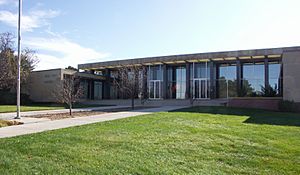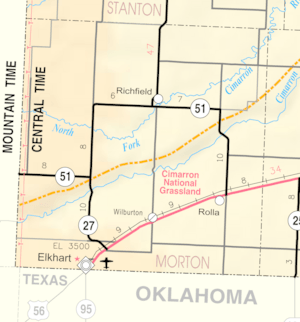Elkhart, Kansas facts for kids
Quick facts for kids
Elkhart, Kansas
|
|
|---|---|
|
City and County seat
|
|

Morton County Court House (2009)
|
|

Location within Morton County and Kansas
|
|

|
|
| Country | United States |
| State | Kansas |
| County | Morton |
| Founded | 1913 |
| Incorporated | 1913 |
| Named for | Elkhart, Indiana |
| Government | |
| • Type | Mayor–Council |
| Area | |
| • Total | 2.05 sq mi (5.32 km2) |
| • Land | 2.05 sq mi (5.32 km2) |
| • Water | 0.00 sq mi (0.00 km2) |
| Elevation | 3,596 ft (1,096 m) |
| Population
(2020)
|
|
| • Total | 1,888 |
| • Density | 921.0/sq mi (354.9/km2) |
| Time zone | UTC-6 (CST) |
| • Summer (DST) | UTC-5 (CDT) |
| ZIP code |
67950
|
| Area code | 620 |
| FIPS code | 20-20350 |
| GNIS ID | 2394655 |
Elkhart is a city in Kansas, United States. It's also the main town, or county seat, of Morton County. In 2020, about 1,888 people lived there. Elkhart is located right on the border with Oklahoma to the south, and it's not far from the Colorado border either.
Contents
History of Elkhart
Elkhart was started in 1913. It got its name from another city called Elkhart, Indiana.
A railroad line, the Elkhart and Santa Fe Railway, started here. It was built in 1925 and went into Oklahoma and later New Mexico. However, it was closed down in 1942.
In 1961, Elkhart became the county seat. This means it became the center for the local government of Morton County. Before that, the county seat was in a town called Richfield.
Geography and Climate
Where Elkhart is Located
According to the United States Census Bureau, Elkhart covers about 2.11 square miles (5.46 square kilometers) of land. There is no water area within the city limits.
Elkhart's Climate
Elkhart has a cool semi-arid climate. This means it's generally dry, especially in winter. Temperatures can change a lot. Summers are hot, but sometimes there are heavy thunderstorms.
During winter, it doesn't rain or snow much. Temperatures can sometimes get very warm, even in the middle of winter, because of strong winds. However, cold air from Canada can also make temperatures drop below 0°F (minus 18°C). The coldest temperature ever recorded was minus 22°F (minus 30°C) in 1984.
Snowfall is usually light because it's so dry. But in February 1903, there was a lot of snow, about 41 inches (1 meter)!
In summer, it's very hot. Most of the yearly rain comes from thunderstorms. Sometimes, it can get extremely hot for many days in a row. For example, in July 1980, the average high temperature was 103°F (39°C). But when the weather changes, there can be very heavy rain. In April 2016, over 10 inches (250 mm) of rain fell.
| Climate data for Elkhart, Kansas, 1991–2020 normals, extremes 1900–present | |||||||||||||
|---|---|---|---|---|---|---|---|---|---|---|---|---|---|
| Month | Jan | Feb | Mar | Apr | May | Jun | Jul | Aug | Sep | Oct | Nov | Dec | Year |
| Record high °F (°C) | 83 (28) |
87 (31) |
92 (33) |
96 (36) |
104 (40) |
110 (43) |
110 (43) |
108 (42) |
105 (41) |
97 (36) |
91 (33) |
85 (29) |
110 (43) |
| Mean maximum °F (°C) | 70.1 (21.2) |
74.9 (23.8) |
83.0 (28.3) |
88.4 (31.3) |
95.7 (35.4) |
102.4 (39.1) |
103.2 (39.6) |
100.9 (38.3) |
97.6 (36.4) |
90.6 (32.6) |
79.4 (26.3) |
70.5 (21.4) |
104.7 (40.4) |
| Mean daily maximum °F (°C) | 47.7 (8.7) |
51.5 (10.8) |
60.4 (15.8) |
68.8 (20.4) |
79.0 (26.1) |
89.4 (31.9) |
93.4 (34.1) |
90.8 (32.7) |
83.5 (28.6) |
71.3 (21.8) |
58.3 (14.6) |
48.0 (8.9) |
70.2 (21.2) |
| Daily mean °F (°C) | 34.5 (1.4) |
37.3 (2.9) |
45.7 (7.6) |
54.0 (12.2) |
64.2 (17.9) |
74.7 (23.7) |
79.2 (26.2) |
77.0 (25.0) |
69.1 (20.6) |
56.6 (13.7) |
44.8 (7.1) |
35.3 (1.8) |
56.0 (13.3) |
| Mean daily minimum °F (°C) | 21.3 (−5.9) |
23.2 (−4.9) |
31.0 (−0.6) |
39.2 (4.0) |
49.5 (9.7) |
60.0 (15.6) |
64.9 (18.3) |
63.2 (17.3) |
54.8 (12.7) |
41.9 (5.5) |
31.2 (−0.4) |
22.6 (−5.2) |
41.9 (5.5) |
| Mean minimum °F (°C) | 5.1 (−14.9) |
9.0 (−12.8) |
15.3 (−9.3) |
25.8 (−3.4) |
36.9 (2.7) |
50.2 (10.1) |
57.7 (14.3) |
55.9 (13.3) |
42.0 (5.6) |
27.2 (−2.7) |
16.1 (−8.8) |
6.8 (−14.0) |
−0.1 (−17.8) |
| Record low °F (°C) | −22 (−30) |
−18 (−28) |
−18 (−28) |
8 (−13) |
21 (−6) |
33 (1) |
45 (7) |
43 (6) |
25 (−4) |
6 (−14) |
−7 (−22) |
−18 (−28) |
−22 (−30) |
| Average precipitation inches (mm) | 0.43 (11) |
0.31 (7.9) |
1.00 (25) |
1.86 (47) |
2.22 (56) |
2.55 (65) |
2.94 (75) |
2.95 (75) |
1.24 (31) |
1.67 (42) |
0.49 (12) |
0.74 (19) |
18.40 (467) |
| Average snowfall inches (cm) | 4.2 (11) |
2.1 (5.3) |
3.5 (8.9) |
0.4 (1.0) |
0.8 (2.0) |
0.0 (0.0) |
0.0 (0.0) |
0.0 (0.0) |
0.0 (0.0) |
0.7 (1.8) |
1.2 (3.0) |
4.7 (12) |
17.6 (45) |
| Average precipitation days (≥ 0.01 in) | 2.5 | 2.7 | 3.8 | 5.4 | 6.3 | 6.8 | 7.5 | 7.1 | 4.4 | 4.0 | 2.7 | 3.5 | 56.7 |
| Average snowy days (≥ 0.1 in) | 2.0 | 1.5 | 1.4 | 0.2 | 0.0 | 0.0 | 0.0 | 0.0 | 0.0 | 0.3 | 0.8 | 2.2 | 8.4 |
| Source 1: NOAA | |||||||||||||
| Source 2: National Weather Service | |||||||||||||
People of Elkhart (Demographics)
In 2020, the census counted 1,888 people living in Elkhart. There were 729 households, which are groups of people living together.
Population Details (2020)
- About 75% of the people were White.
- About 10% were from other races, and nearly 12% were from two or more races.
- About 23.5% of the population was Hispanic or Latino.
- About 31.7% of households had children under 18.
- Most households (50.3%) were married couples.
- About 25% of the population was under 18 years old.
- About 21.5% of the population was 65 years or older.
- The average age in Elkhart was 41.1 years.
Population Details (2010)
In 2010, there were 2,205 people living in Elkhart.
- About 87.7% of the people were White.
- About 20.7% of the population was Hispanic or Latino.
- About 33.8% of households had children under 18.
- About 26.4% of residents were under 18 years old.
- About 17.6% were 65 years or older.
- The average age in the city was 38.4 years.
Education
The local public schools in Elkhart are part of the Elkhart USD 218 school district. The mascot for Elkhart High School is the Wildcats.
Notable People from Elkhart
- Sanora Babb: A writer.
- Walter Thane Baker: A sprinter who won two Olympic medals in 1952 and 1956.
- Glenn Cunningham: A long-distance runner who once held the world record for the 1-mile race and won an Olympic silver medal in 1936.
- Robelyn Garcia: A former professional basketball player.
- Jerry Simmons: An NFL strength and conditioning coach for 23 years.
- Darrin Simmons: A football coach for the special teams of the Cincinnati Bengals.
Images for kids
See also
 In Spanish: Elkhart (Kansas) para niños
In Spanish: Elkhart (Kansas) para niños


